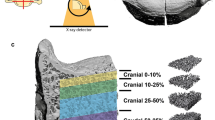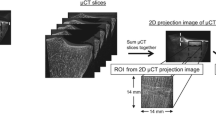Abstract:
Different noninvasive techniques for the assessment of the individual fracture risk in osteoporosis are introduced, and the relation between structural properties of high-resolution computed tomography (HR-CT) images of vertebral bodies, their bone mineral density (BMD) and the fracture load is analyzed. In 24 unfractured lumbar vertebrae with different degrees of demineralization from six specimens, the trabecular and cortical BMD was determined using quantitative CT. A lateral X-ray image revealed the number of fractures in the entire spine. A structural analysis of spongy and cortical bone was performed based on the HR-CT images. In the spongiosa, the fractal dimension was calculated as a function of the threshold value. In the cortical shell, the maximum number of clusters of low BMD was determined at varying threshold values. After the CT measurements the vertebrae were excised and compressed until fractured. On the basis of the spongiosa BMD and the number of fractures, 3 cases were found to be severely osteoporotic; the other 3 cases showed osteopenia. The average fracture loads were determined as 3533 N for the non-osteoporotic cases (range 2602–5802 N) and 1725 N for the osteoporotic cases (range 1311–2490 N). The parameters were determined as follows: average spongiosa BMD 115.2 mg/ml (101.8–135.3 mg/ml) for the non-osteoporotic cases, 46.2 mg/ml (34.8–57.6 mg/ml) for the osteoporotic cases; average cortical BMD 285.1 mg/ml (216.4–361.9 mg/ml) for the non-osteoporotic cases, 136.1 mg/ml (142.5–215.2 mg/ml) for the osteoporotic cases; spongiosa structure: average 0.5 (range 0.32–0.75) for the non-osteoporotic cases, average 1.05 (range 0.87–1.24) for the osteoporotic cases; cortical structure: average 81 (range 55–104) for the non-osteoporotic cases), average 136 (range 102–159) for the osteoporotic cases. Single parameters (BMD and structure) and weighted sums of these parameters were correlated with the fracture load, resulting in correlation coefficients of r sBMD= 0.82 (spongiosa BMD), r cBMD= 0.82 (cortical BMD), r sStr=–0.75 (spongiosa structure) and r cStr=–0.86 (cortical structure). The weighted sum of cortical and spongiosa BMD resulted in r BMD= 0.86, of cortical and spongiosa structure in r Str=–0.86. A weighted combination of all four parameters correlates with the fracture load at r 4= 0.89, all correlations being statistically significant (p<0.0001). The four individual parameters show only a slight overlap between non-osteoporotic and osteoporotic subjects. The high correlation of the cortical BMD and the structural parameter in cortical bone indicates the important contribution of the cortical shell to vertebral stability. A weighted sum of multiple parameters results in a higher correlation with the fracture load and does not show an overlap between the two groups. It is best suited to estimate the individual fracture risk. The presented methods are generally applicable in vivo; and allow an improvement of the diagnosis of osteoporosis compared with the measurement of the BMD alone.
Similar content being viewed by others
Author information
Authors and Affiliations
Additional information
Received: 7 November 1997 / Accepted: 28 September 1998
Rights and permissions
About this article
Cite this article
Haidekker, M., Andresen, R. & Werner, H. Relationship Between Structural Parameters, Bone Mineral Density and Fracture Load in Lumbar Vertebrae, Based on High-Resolution Computed Tomography, Quantitative Computed Tomography and Compression Tests . Osteoporos Int 9, 433–440 (1999). https://doi.org/10.1007/s001980050168
Issue Date:
DOI: https://doi.org/10.1007/s001980050168




